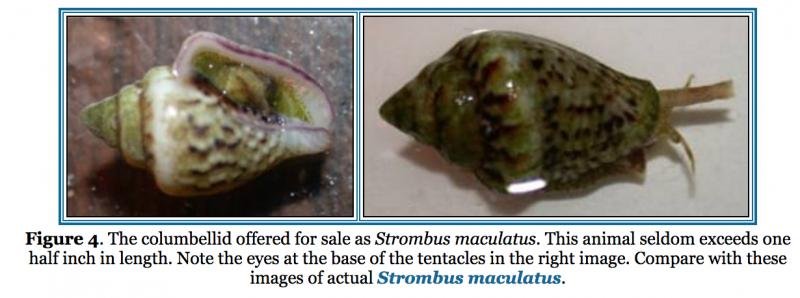Thanks for the lead - awesome!
IPSF had this description in an old page, and no it seems they no longer sell these on the site. I'll inquire directly.
"12 Strombus Grazers tm (Strombus maculatus). The marine aquarium industry's hottest new grazer. Reef-safe, highly active, approx. 1/4 inch shell. These are miniature Pacific relatives of the famous Queen Conch known from Caribbean waters. Hawaiian Strombus Grazers stay small and never exceed about 1/2 inch in length. They are the perfect size for reef aquariums! Many customers report that our Strombus Grazers lay eggs on the front glass, giving rise about 2 weeks later to hundreds of baby snails. An army of small algae eaters working day and night to keep your tank free of problem algae! Of course ours are 100% captive-bred. Grow your own! Add right-side-up to sand at bottom of tank, after acclimation."
and from another
defunct page on IPSF
"Species: Strombus maculatus
Taxonomy: prosobranch gastropod mollusc
Maximum size: 1/2 inch
Diet: diatoms, algal films, low turf algae
Method of production: 100% Captive-Bred at Indo-Pacific Sea Farms
Benefit to reef tank: algal grazing and egg production*, cyanobacteria control**
Number of egg capsules produced: 2-4 per spawning event
Number of eggs per capsule: 4-10
Time to hatching: 3-4 weeks
Type of development: benthic, direct (no planktonic phase)
Available in the Mix and Match Special or the Reef Tank Tuneup"
I wonder if they are actually these
Columbellids mentioned here...
"Interestingly enough, at least one species has been marketed quite successfully as a herbivore, and indeed this species is a good algae-eating snail. This species, although sold as the Pacific spotted conch, Strombus maculatus, is not that species, and actually is a columbellid snail, probably in the genus Euplica or Pyrene. The taxonomic status of that particular genus is uncertain, but in any case, it is a columbellid, similar to what is illustrated as Pyrene versicolor (Note: the linked image is reversed, the aperture should be on the right) by Abbot and Dance, 1982; p161. This particular species reproduces well in aquaria by laying capsules on the walls of the aquarium. Successful reproduction in aquaria is frequent, and these nice little snails are becoming quite commonly found in marine aquaria throughout the United States."
What you think?


